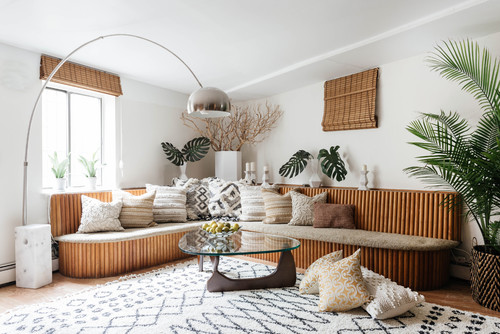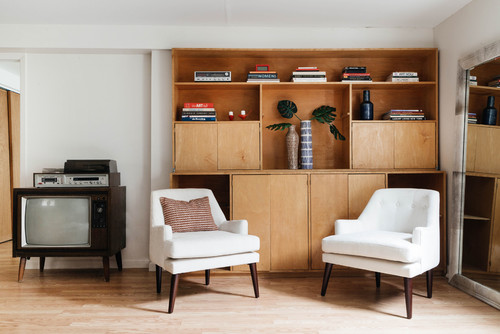As the co-owner of a modern-day receiving & delivery business and the Head of Marketing & Operations for Design Shop Interiors / The Shop by DSI, I have a deep rooted 360° view of the interior design and furniture businesses.
After years of working with designers on a regular basis, I’ve learned that the receiving industry continues to be a pain point for the interior design community. I’m sharing this guide, a love note to designers if you will, in an effort to strengthen the relationship between receivers and designers.
Here’s a list for any designer – just starting or veterans – that can help improve your relationship with your receiver and the product/output you receive. This guide could validate you have a good receiver, or, maybe complacency set in and it’s time to look around.
Written by Scott Jaworski
1. Visit your receiving warehouse and meet the team
-Give them the courtesy of a 24-hour notice, you’re not trying to “catch them”.
-Meeting face-to-face goes a long way in understanding personalities. Learn how you’ll work together when the pressure rises (it will!) and can even help answer some unknowns.
-Is everything covered? Ask the receiver if they can ensure all of their product always has a protective layer. Warehouse dust is a real thing! It’s very different than your home’s dust bunnies; a fine-layer of dust and it’s everywhere, no matter how much one cleans.
Note: Yes, we have a Dyson, shop vac and leaf blower all at our warehouse.
2. Ask about their organizational systems
-When you make the visit noted above, do things appear organized? Can they clearly articulate their systems for tracking product? What about the paperwork?
-Bill Of Ladings (BOLs) are legally binding agreements; very important documents! Producing a signed and dated BOL is required if a claim is necessary. Receivers write notes about the condition of products received on this which is equally valuable.
-If you see that racks and products are not clearly labeled, BOLs are piled up on desks and not filed, or there’s no centralized intake location for deliveries, these are signs of a receiver to stay away from.
Note: We once informed a client that one of her products was damaged. Fast forward approximately 6 weeks and a different employee reached out stating they submitted the claim, but it was declined due to time lapse. She asked, “When did we let them know it was damaged?” Within 60 seconds I was able to look up who and the exact time (11:42 am) the notification was sent via our systems.
3. Make certain you’re aligned on definitions and expectations
-Especially inspections – what’s inspected, what isn’t and why?
-All items may not need to be inspected; this could save you money too.
Note: We believe rugs are best left in their original packaging. If a client requests, we’ll open and inspect. If the packaging is torn, etc. we’ll pro-actively inspect.
4. Where are they located?
-Is it easy for you to get to (if local)?
-Does their warehouse have loading docks, roll-up doors, etc.
Note: Not all are required, IF the bullet above is True AND they have a forklift. Does it allow for big rigs?
Note: This is a non-negotiable – 53’ trucks need the ability to easily arrive, park (they could be there for hours pending delivery size) and leave.
5. Pricing models and transparency
I can’t say I’ve ever seen the same pricing model, but at a minimum, you and your client should know what you’re paying for. There are various pricing models including (but not limited to) per piece pricing, per sq. ft., the percentage of cost of product purchased, per truck, and more.
Note: our invoices have dedicated line-items for each applicable cost – receiving/inspecting, delivery/installation, storage, fuel, etc.
Don’t forget what goes into the job (there are many “behind the scenes” tasks that take time & manpower).
-Off-loading freight can take hours. It’s not uncommon to receive 50+ pieces on one truck which can take 2-3hrs.
-Tracking rightful owner. Receiving a single product with improper or no side marks can quickly burn 30 minutes.
*Tip – include your name or project name with Receiving Business Name on mailing address – this will ensure visibility to receiver.
-Uncrating, oversized items, multiple-boxes/crates per single piece – these can require multiple people and increased time.
*Note: we created a video that shows how it took 2 guys almost 30 minutes to inspect 1 console table.
-Rewrapping – a fair amount of packaging is one-time use. This means it requires receivers use their own packaging material; which also comes at a cost. A case of tape can run from $65 – $90. One roll of stretch wrap (plastic) cane run from $20 – $25
-Loading the truck for safe transport – a full-house install can take a team of two 6-7 hours to properly load a vehicle.
-Then there’s the install itself, but the receivers’ job isn’t done yet…
-Removal and recycling of trash.
-Post-install, trash is loaded back in the truck, returned to the warehouse, transferred to a hydraulic dump trailer, driven to the municipality (the receiver pays per ton to dispose) to return back to the warehouse.
-The entire process can take 4-5 hours and the average install produces 300-600 pounds of trash that needs to be hauled.
6. What does the receivers fleet consist of?
-Do they own or rent their trucks?
Note: If they rent their trucks and you cancel last minute or require a last minute install you could pay more or they might not be able to deliver.
-Are they branded/wrapped?
Note: You’re offering a luxury service, the partners you align yourself with should carry this through.
-Are there various sized vehicles?
Note: Cost efficiency – if you have a small job and they have one large vehicle, you could be overpaying. Alternately, if you have a large job and they have a small truck, you could be paying to rent another one.
7. Play the “what if game”
-Issues will occur, such as damaged goods discovered at the install. Provide use cases or scenarios to see how they would handle those.
Note: If you’re new to using receivers, ask your community or make a post in the Ivy Facebook group – designers will share their stories you can propose as use cases.
8. Ask about their network and relationships
-Not only is it important to have relationships with the freight carriers, but manufacturers and their reps.
-It is a fact that a receiver will have to call upon one of the aforementioned to help solve an issue. Do they have the relationships in place to solve what could be one of your problems?
Note: we have a fridge of beverages, snacks and a bathroom we make available to all of our delivery/freight drivers – a Monster and M&Ms go a long way. On a serious note, due to my background, I have the luxury of knowing most of the manufacturer reps in Northern California and we are a team who help each other.
9. Damage; oh, my damage.
-How will your receiver help address/minimize damage?
Note: We have a network of trade professionals who come to our warehouse, provide free estimates and will return to facilitate the work. Product never has to leave; designer is reimbursed by manufacturer and product returns to quality condition faster than filing a claim.
10. What are the receivers preferred methods and modes of communication?
-Do these align to your expectations? From a receiver’s perspective, the following expectations are reasonable: Phone, text, and email during office hours. 48-hours prior to install after hours communication may be required. Same-day notifications regarding a change in product status (received, inspection results, etc.). Photography should be a must.
-Does the receiver have one or many contacts; should you require something promptly?
Note: If you have to file a claim, you’ll be required to provide a fair amount of information – copy of BOL, picture(s) of box/product/tags, etc. How and how quickly will you receive this information? Claims require a timely response.
Want to have some fun? Here’s a bonus:
If you visit your receivers’ warehouse, open the fridge.
-Are the drinks grouped and all labels facing forward?
Note: Per Justin (my business partner) – “that’s when you know you have a real case of OCD on your hands”. I plead guilty.
In summary, receiving is about accuracy. It’s about knowing (at all times) where a product is and its condition. The means by which this happens is what you’re seeking in all of your receiving partner assessments.
I hope you found this helpful & informational. If you have any questions or thoughts, please feel free to email me directly at: scott@rightwayreceiving.com or follow us @RightWayReceiving
Ivy is the leading business management platform and community helping home professionals streamline their businesses by providing the technology, resources, and support they need to thrive. To learn more about Ivy, schedule a demo with an Ivy Guru who can show you how designers use Ivy to streamline their workflow and make more time for what they love, design.























